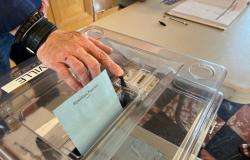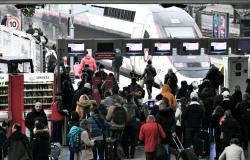Aurélie De Lanlay is deputy director of the Rencontres d’Arles which will open its doors on July 1 for three months with no less than forty exhibitions and some 4,200 works to discover or rediscover.
Objectif Gard: What is the program for the 55th edition of the Rencontres de la photographie d’Arles which begins on Monday?
Aurélie De Lanlay: We have built a program in which we present forty exhibitions spread across twenty-five heritage sites located in the city. These are exhibitions around photography in all its forms with great historical figures whose work we revisit, group exhibitions which resonate with current events or which allow us to consider photography with another look, from emerging photography or even photo archives… and around that we deploy a certain number of sequences. The first of them is called Remous, it thus echoes the subtitle of this 55th edition which is Sous la surface.
This year’s program will particularly focus on the work of Mary Ellen Mark through a first major world retrospective of the work of this American photographer.
Indeed! One of the roles of the Rencontres d’Arles is to show a photograph of the contemporary French scene but also to open up to international perspectives by revisiting in particular the work of photographers whose retrospectives have not always been carried out. This is the case with Mary Ellen Mark whose work we are very happy to present. She was able to bring a humanist and documentary perspective on the world around her with an extreme sensitivity concerning in particular daily life in what it can sometimes have of rough, producing portraits, often of people on the margins, with great empathy. It is important for us to show the role of the photographer and the perspective he can have on society, and how this can today enlighten our own perspective on the world around us.
“Understanding the photography of Japanese women photographers”
What can you say about Stephen Dock’s work that will be presented at the Cruise space?
Stephen Dock was initially a self-taught French war photographer in his forties who had worked for the press for a long time. Little by little, he revisited his own photographic archives by questioning the notion of distance. The distance that he himself has on site when he photographs scenes, the distance that he can introduce as a photographer in relation to the viewer by reinterpreting his images, their forms, their presentation. Using various techniques and using current tools, he has chosen to look at his archives differently by writing his own authorial work while relying on references linked to the history of photography. It is a very interesting artist’s project, which, by moving away from pure documentary photography, presents a certain number of levels of reading, from the use of photography to the deconstruction of the image of war.
Japanese photography is also in the spotlight this year.
Indeed! We are presenting several projects around Japan and Japanese photography, including two exhibitions, one of which will be held at the Archbishop’s Palace with the presentation of works by 26 Japanese photographers from the 1950s to the present day. Visitors will be able to discover the diversity of the images exhibited and the different approaches taken by the photographers. It is an opportunity for everyone, in light of the rest of the exhibitions and the diversity of the projects, to understand the photography of Japanese women photographers. We know Japanese photography quite well in the history of photography, but we mainly know the work of Japanese photographers, and relatively little about the work of Japanese women photographers. This exhibition is an opportunity to discover, over the last century and up to the present day, the place, the perspective and the experiments carried out by Japanese photographers. The diversity of photographic approaches, the richness of the series, the historical and social issues on Japanese society make this exhibition fascinating and necessary.
“Succeeding in bringing the public into a new universe”
Among the invited photographers, this year there is Sophie Calle who divides her time between Paris and the small village of Cailar in the Gard. What motivated this choice?
She is the one who motivated this choice! (Smile) Last year, in September, she visited Juliette Agnel’s exhibition on the prehistoric caves of Arcy-sur-Cure in Yonne, which was installed at the cryptoportiques – a place often little known to the public! –; and this, at the very moment when the works were starting to be damaged due to a very high humidity level. After seeing the exhibition, she said to Christoph Wiesner (the director of the Rencontres d’Arles, Editor’s note): I have a project for you! And it is the one that the public will discover this year through a very moving exhibition that brings together, among other things, the photos from her series Les Aveugles which suffered water damage a few months ago… This exhibition, which is of course being held at the cryptoportiques, raises the question of the artist’s gaze, of disappearance, of absence and of the place that the works find in time.
For the first time, the Rencontres presents work around graffiti, a universe which is not directly linked to photography!
This is also what the Rencontres d’Arles are all about: for each project, succeeding in bringing the public into a new universe. This is what makes it so that when we come to the festival there are things that we will love and others that will surprise us. And each time, there are surprises, and that is what we are looking for: to surprise visitors! Of course, graffiti is not photography, but what interests us is how a movement of appropriation of urban space and rebellion has been able to make a place for itself in France and elsewhere for thirty years, and how photography as a medium has made it possible to both document and develop this movement.
“Photography plays an essential role in our lives”
Part of the impressive collection of the Fondation A (Collection Astrid Ullens de Shooten) dedicated to documentary photography will also be presented at the Mécanique générale…
It’s yet another path for photography! Each year, the Meetings pay particular attention to the question of the collection. The specificity of Astrid Ullens’ collection is that it is made up of more than 5,000 works created by around a hundred artists who each have very long series. This collection is built around documentary photography. We discover great figures of photography such as Bernd and Hilla Becher, Robert Adams, Lee Friedlander and Walker Evans. This exhibition, which includes hundreds of photos, is also a way of revisiting the history of photography.
Do the Rencontre d’Arles also pay attention to the edition of the photo book?
Yes. For several years, we have been very attached to photographic publishing because the photo book is an essential tool for the photographer. He uses it both to think about his series and his project and to distribute and share his work. This year again there will be the Book Awards whose aim is to support the development of photographic publishing and to contribute to its wider distribution.
What is your view on the future of photography?
Photography plays an essential role in our lives. We only need to look at our mobile phones or at people in the street with their smartphones in their hands to realize the place that images occupy in our daily lives. Spaces like ours, and like many others too, are absolutely essential to continue to constantly think about the medium, to allow artists, photographers, exhibition curators to reveal their vision, their gaze, their voice of a world in perpetual motion in multiple and personal stories.
Complete program of the Rencontres d’Arles on the website www.rencontres-arles.com






